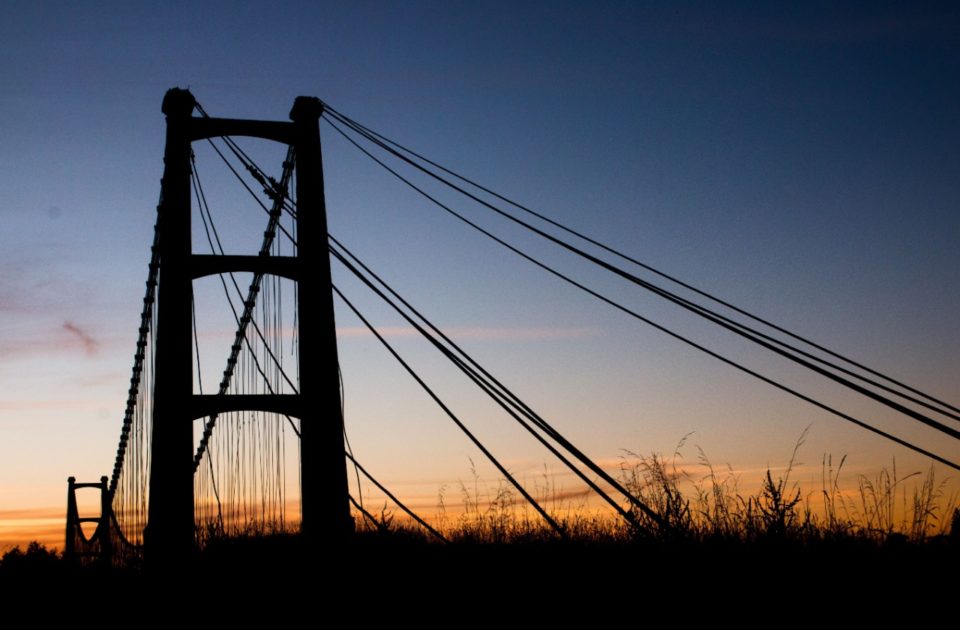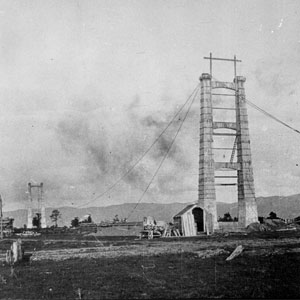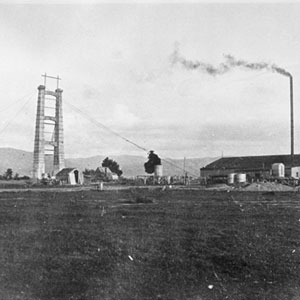PHOTOGRAPHS COURTESY OF THE PALMERSTON NORTH CITY LIBRARY/MANAWATU HERITAGE COLLECTION
When driving north on SH56, over the low-lying flood plains flanking the Manawatu River, you cannot but help notice an old suspension bridge and a tall chimney sprouting from what is now farmland. Richard Silcock explains.
Today, the Opiki suspension bridge is no more than skeletal remains. The steel suspension cables blow in the wind and the wooden decking is in a sad state of disrepair with most of it now removed or fallen into the river.
The two concrete twin piers on either-side of the river remain intact and stand like sentinels to days long past.
Once, harakeke (flax) grew naturally in abundance around the region, in what local Maori called ‘the great swamp’. They harvested the flax to weave and make clothing, baskets and rope and it is known they traded the flax.
Between the mid-1860s and the 1920s, the 5900-hectare Makerua Swamp became the centre for a thriving flax industry.1
At the height of production some 30-odd flax mills were drying, stripping and processing the flax before transporting it to the railway station at Rongiotu, or to the port at Foxton from where it was shipped.2 / 3
To transport the flax over the river to the railway or port required using a flying-fox suspended cage or, when the river level was sufficiently low, a cable-drawn punt.
These methods were slow and hindered production, so the Tane Hemp and Makerua Flax companies4, which had the largest flax stripping mills in the area, commissioned the bridge in 1916 and, following two years of construction, it opened in January 1918 at a cost of £2821.

It was designed and constructed by Joseph Dawson, who, during his time as a civil engineer was responsible for constructing 15 similar suspension bridges around the country. He specialised in suspension bridges and patented a number of construction techniques and design features.
Dawson had moved from Tasmania where he had gained experience constructing bridges. In the 1870s he moved to the Wairarapa, having purchased a farm but continued practising as a self-taught bridge engineer.5
He was responsible for constructing a number of bridges over the Hutt River in the Wellington region and in the Manawatu, Wairarapa and Rangitikie where he designed and supervised construction of the Mokai Bridge over the Rangitikie River – all of which no longer exist. He earned a reputation for ‘economy and very sound construction work, as well as speed of erection.’
When the 154.4 metre long, 3.3 metre-wide, Opiki suspension bridge was completed it heralded single-span bridge design in NZ with its impressive twin-tower structures and wire cable catenaries.
The cables stretched over and between the towers and anchored in concrete blocks buried 5.2 metres in the ground several metres back. The deck was built of beech timber and allowed loadings of up to three tonnes.
In order to cut cost, it is understood the labour to construct the bridge was provided by the mill workers. The suspension rods were fabricated by the mill’s blacksmith and the 16 suspension cables were recycled from former gold-mining operations in Waihi.
At the time it was the longest, single span road bridge in New Zealand (and possibly Australasia) and one of the first to use reinforced concrete.
The use of reinforced concrete for the 14.6 metre-high, tapered twin-towers, that stand on three-metre deep concrete abutments are a testament to the use of new technology which was being embraced by engineers at the time.
The remaining 20 metre-high reinforced concrete chimney, marks the location of the former Tane mill. Most of the flax processing machinery was powered by a wood-fired steam engine and the tall chimney dispelled the smoke.
When a devastating ‘yellow-leaf’ disease struck the plantations, followed by a post-war slump in demand for flax, many of the mills closed resulting in the swampland being drained between1925 and 1930 and turned into farmland. An advertisement in a local paper trumpeted it as ‘one of the most beautiful tracts of grassland one could see’.
One of the former Tane mill owners, Hugh Akers, took ownership of the bridge, built a bridge-keeper’s house and charged a toll to users of the bridge. This infuriated locals and when the Minister for Public Works, Bob Semple was asked to pay a toll by the toll-keeper it is reported he shouted:
“This structure from a comic opera must go – we will build a new bridge – we will not have toll bridges in this country!”
The bridge became known as the Tane swing bridge and gained distinction for being the only privately owned toll bridge in the country’s road network.6
It was not until 1969 that a new, 138 metre-long, two-lane concrete road bridge was built by the Ministry of Works, making the Opiki suspension bridge redundant.
While long decommissioned, the old chimney did see some action during WW2, acting as a Home Guard observation post.
Over time, weather, river currents, floods and vegetation have taken their toll on the bridge and chimney, which are now just monuments to a past era and a curious vertical landmark to those passing by. The unsealed road to the bridge can just be discerned, albeit over-grown.
Due to its design and the technology at the time of its construction in this country the Opiki suspension bridge is registered as a Category-1 historic place and an information cairn and plaque can be found at the side of SH56.
FOOTNOTES
1 The Makerua Swamp, which stretched between Linton to the north-east, Shannon to the south-east and Foxton to the west, became the largest commercial flax producing area in the country.
2 Flax played an important part in the national economy during the early part of the 20th century, particularly in the economic development of the Manawatu and Horowhenua regions. By 1918 flax fibre accounted for around 10 percent of this country’s exports.
3 Foxton, near the mouth of the Manawatu River was a thriving port for coastal scows which could navigate the lower reaches of the river to load flax. Production peaked between the late 1880s, (when the Wellington to Manawatu Railway opened) and 1918-19. The port closed in the early 1940s following closure of the remaining mills and diversion of the river.
4 The Tane Hemp Company was owned by the Aker brothers who ran one of the largest flax mill operations in the region. Another large mill, the Makerua Flax Company was formed in 1902 and funded by Wellington businessman and entrepreneur John Plimmer (known as the father of Wellington commerce) and flax miller Alfred Seifert who purchased 12,343 acres of swampland for commercial flax propagation.
5 It was around this time that the newly formed NZ Society of Civil Engineers was calling for greater regulation of engineers and the resulting Civil Engineers Registration Act 1924 brought an end to self-taught, unqualified engineers.
6 The Auckland Harbour Bridge, when opened on 30 May 1959, was the only other bridge in NZ to charge a toll.
• The author acknowledges information for this article was gained from a report by historian Karen Ashwood (NZ Historic Places Trust) and from articles published in the Manawatu Standard and Horowhenua Chronicle.





Parting words from Jeremy Sole- a final column